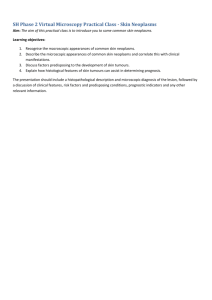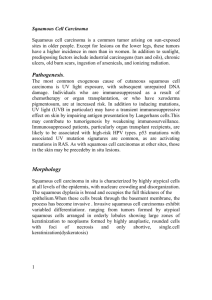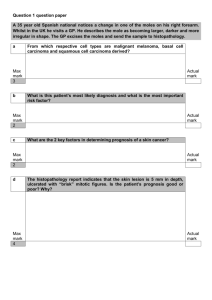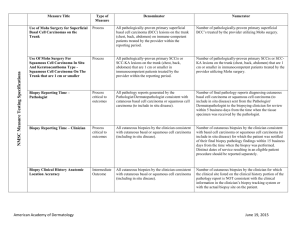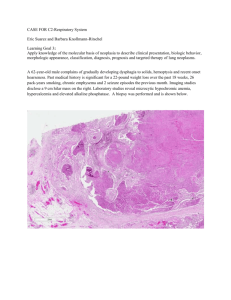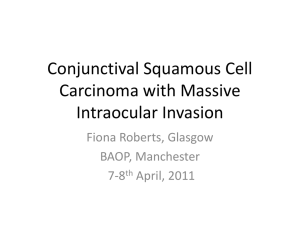AgNORs IN SQUAMOUS CELL CARCINOMA OF HEAD AND NECK
advertisement
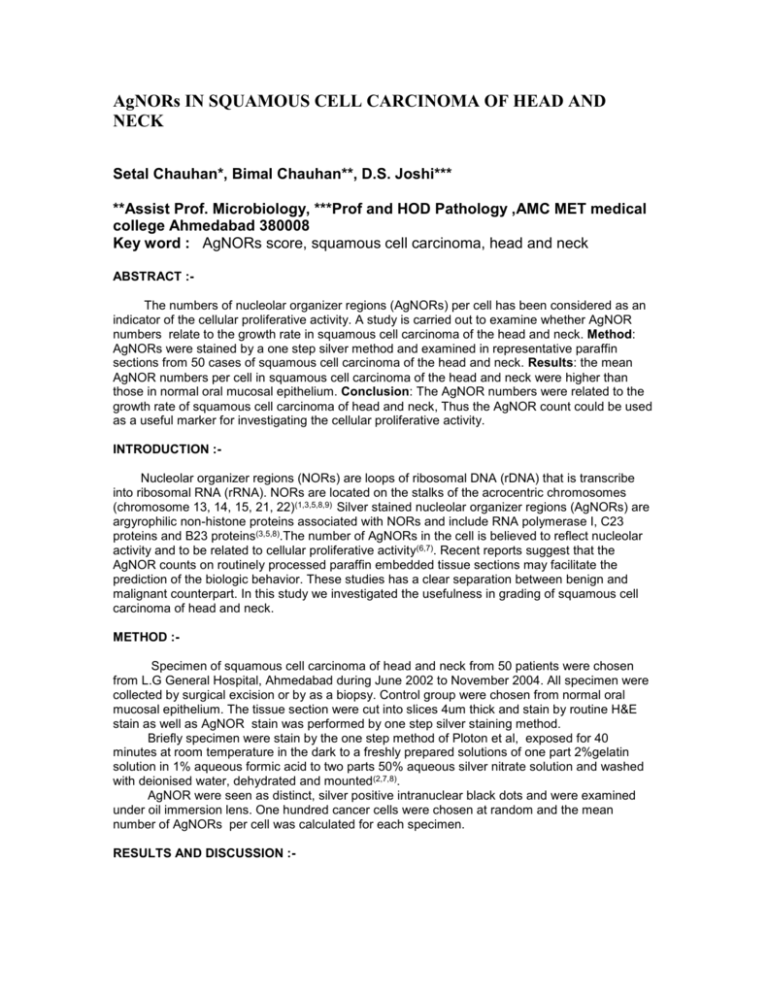
AgNORs IN SQUAMOUS CELL CARCINOMA OF HEAD AND NECK Setal Chauhan*, Bimal Chauhan**, D.S. Joshi*** **Assist Prof. Microbiology, ***Prof and HOD Pathology ,AMC MET medical college Ahmedabad 380008 Key word : AgNORs score, squamous cell carcinoma, head and neck ABSTRACT :The numbers of nucleolar organizer regions (AgNORs) per cell has been considered as an indicator of the cellular proliferative activity. A study is carried out to examine whether AgNOR numbers relate to the growth rate in squamous cell carcinoma of the head and neck. Method: AgNORs were stained by a one step silver method and examined in representative paraffin sections from 50 cases of squamous cell carcinoma of the head and neck. Results: the mean AgNOR numbers per cell in squamous cell carcinoma of the head and neck were higher than those in normal oral mucosal epithelium. Conclusion: The AgNOR numbers were related to the growth rate of squamous cell carcinoma of head and neck, Thus the AgNOR count could be used as a useful marker for investigating the cellular proliferative activity. INTRODUCTION :Nucleolar organizer regions (NORs) are loops of ribosomal DNA (rDNA) that is transcribe into ribosomal RNA (rRNA). NORs are located on the stalks of the acrocentric chromosomes (chromosome 13, 14, 15, 21, 22)(1,3,5,8,9) Silver stained nucleolar organizer regions (AgNORs) are argyrophilic non-histone proteins associated with NORs and include RNA polymerase I, C23 proteins and B23 proteins(3,5,8).The number of AgNORs in the cell is believed to reflect nucleolar activity and to be related to cellular proliferative activity(6,7). Recent reports suggest that the AgNOR counts on routinely processed paraffin embedded tissue sections may facilitate the prediction of the biologic behavior. These studies has a clear separation between benign and malignant counterpart. In this study we investigated the usefulness in grading of squamous cell carcinoma of head and neck. METHOD :Specimen of squamous cell carcinoma of head and neck from 50 patients were chosen from L.G General Hospital, Ahmedabad during June 2002 to November 2004. All specimen were collected by surgical excision or by as a biopsy. Control group were chosen from normal oral mucosal epithelium. The tissue section were cut into slices 4um thick and stain by routine H&E stain as well as AgNOR stain was performed by one step silver staining method. Briefly specimen were stain by the one step method of Ploton et al, exposed for 40 minutes at room temperature in the dark to a freshly prepared solutions of one part 2%gelatin solution in 1% aqueous formic acid to two parts 50% aqueous silver nitrate solution and washed with deionised water, dehydrated and mounted(2,7,8). AgNOR were seen as distinct, silver positive intranuclear black dots and were examined under oil immersion lens. One hundred cancer cells were chosen at random and the mean number of AgNORs per cell was calculated for each specimen. RESULTS AND DISCUSSION :- Although conventional clinic pathological staging or histological grading or both, may be useful in clinical assessment of squamous cell carcinoma of head and neck, these methods do not determine the growth rate of the tumor in individual patients. The tumor growth rate has been estimated by the cellular proliferative activity of the tumor. In the present study of evaluation of AgNOR count in SCCs of head and neck, mean value was compared with study of other workers and thus it was suggested that this method can be used to differentiate different grades of carcinoma. Recently NORs have been detected by AgNOR staining (2, 7, 8) because this technique of one step silver staining is simple and quick and can be applied to paraffin embedded specimen. The number of AgNORs in the cells of the squamous cell carcinoma of head and neck ranged from 2.39 to 8.95. In present study results of 50 cases were compared according to site, age, sex, and grading and number of AgNOR dots with those of Steven M. Hirsch et al 1992(11), Jozsef piffko et al, 1997(12) and B. Arora et al, 2002(3) . In the present study the number of NOR dots increased with increasing grade of SCCs of head and neck, while the size of the NOR decreased and dots became more irregular with increasing grade. Table 1 shows comparison of site distribution of present study with the study of Steven M.Hirsch et al 1992(11). TABLE – 1 Site Oral cavity Pharynx Larynx Others Total Study of Steven M. Hirsch Present Study No. Of Cases Percentage (%) No. Of Cases Percentage(%) 21 16 22 07 66 33 24 33 10 100 24 11 09 06 50 48 22 18 12 100 Present study found that 35 cases (24+11) of SCCs originated from the oropharynx (70%) whereas Steven M. Hirsch et al study found that 37 cases of SCCs originated from the oropharynx (57%). TABLE – 2 Jozsef Piffko et al study Age Sex Histological Grading <50 Years >50 Years Male Female I II III Present Study No. Of cases Percentage (%) No. Of cases Percentage (%) 42 38 67 13 25 42 11 52 48 84 16 32 54 14 25 25 40 10 13 31 06 50 50 80 20 26 62 12 Table 2 shows the comparison of age, sex and histological grading of present study with the study of Jozsef piffko et al, 1997(12) and all these parameters were correlated with study of Jozsef piffko et al, 1997. Thus the age of the patients varied from 35years to 80years with maximum number of patients in the fifth decade of life. Male to female ratio was 4:1 and majority of the cases of SCCs were in grade-II. TABLE – 3 Grading I II III IV Study of B. Arora et al, 2002 mean AgNOR count 2.39 3.55 5.59 8.95 Present study Mean AgNOR count 2.36 3.72 5.83 - Table 3 shows present study of mean AgNOR count in grade I, II and III was 2.36, 3.72 and 5.83 which was comparable with 2.39,3.55 and 5.59 mean AgNORs in grade I, II and III of D. Arora at al, 2002(3) study. SUMMARY AND CONCLUSION :AgNOR count is useful in distinguishing between low and high grade nonhodgkin’s lymphoma, benign and malignant salivary gland tumors and adenocarcinoma of the colon. (1, 3, 6, 9). Crocker and Nar(7) applied this technique to a large series of NHL and observed that the number of AgNOR dots within the nuclei was much greater in high grade than in low grade and the difference was clear cut without any grey area between the two groups. In recent years DNA flow cytometry, AgNOR counts and ki 67 labeling have been commonly used to study cellular proliferation (4). It is likely that mean number of AgNORs relate to the number of cells in S phase and with ploidy. Thus AgNOR counts may assist in the grading of neoplasm (4). Study shows that AgNOR numbers are related to the growth rate of squamous cell carcinoma of head and neck. REFERENCES :1. B Arora, D jeevan, R S Punia, Sanjay Kumar, DR Arora : AgNORs in squamous cell carcinoma of head and neck. JIMA – Vol. 100. No: 05, May 2002. 2. David A.R. Boldy, John Crocker and Jon G. Ayres: Application of the AgNOR method to cell imprints of lymphoid tissue. Journal of pathology, vol. 157 : 75-79, 1989. 3. D.D. Giri, J.F. Nottingham, J Lawry, S.A.C. Dundas and J.C.E. Underwood : Silver binding nucleolar organizer regions (AgNORs) in benign and malignant breast lesions: Correlation with ploidy and growth phase by DNA flow cytometry. Journal of Pathology, vol 157: 307-313, 1989. 4. Ferhan oz, B oz, S Uraz : Nucleolar organizer regions in squamous cell carcinoma of the larynx. The Otolarengologi, 1997; 35(3-4) : 71-74. 5. J.C.E. Underwood, D.D. Giri : Nucleolar organizer regions as diagnostic discriminants for malignancy. Journal of Pathology, vol. 155: 95-96. (1988) 6. J Crocker, J.C. Macartney and P.J. Smith: correlation between DNA flow cytometric and nucleolar organizer regions data in non-hodgkin’s lymphomas, Journal of pathology, vol 154, 151-156. 1988 7. J Crocker and Paramjit Nar : Nucleolar organizer regions in lymphomas. Journal of Patholoyg, vol 151 : 111-118, 1987. 8. Jia – Haur chern, Yu-chin Lee, Mei-Hai Yang, Shi-Chan Chang, and Reury-Perng: Usefulness of Argyrophilic nucleolar organizer regions score to differentiate suspicious malignancy in pulmonary cytology. CHEST 1997, 111 : June : 1591 – 96 9. P. Yang, G.S. Huang, X S Zhu : Role of nucleolar organiser regions in differentiating malignant form benign tumours of the colon: J. Clin pathol 1990, 43 : 235-238. 10. R.G. Valia ; H.R. Jerajani , S.T. Amladi – skin tumours and lymphoproliferative disorders . Squamous cell carcinoma. IADVL text book and atlas of dermatology. second edition :2001 Volume II ,Page :1158-1159 11. Steven M. Hirsch , James Ducanto , David D. Caldarelli , J.C.Hutchinson , John S . Coon: Nucleolar organizer regions in squamous cell carcinoma of the head and neck : Laryngoscope 102 . 39-44 Jan 1992. 12. Jozsef Piffko, Agnes Bankfalvi, : standardized AgNOR analysis of the invasive tumour front in oral squamous cell carcinomas. Journal of pathology, vol. 182 : 450-456, 1997. 13. B Arora, D jeevan, R S Punia, Sanjay Kumar, DR Arora : AgNORs in squamous cell carcinoma of head and neck. JIMA – Vol. 100. No: 05, May 2002. 14. David A.R. Boldy, John Crocker and Jon G. Ayres: Application of the AgNOR method to cell imprints of lymphoid tissue. Journal of pathology, vol. 157 : 75-79, 1989. 15. D.D. Giri, J.F. Nottingham, J Lawry, S.A.C. Dundas and J.C.E. Underwood : Silver binding nucleolar organizer regions (AgNORs) in benign and malignant breast lesions: Correlation with ploidy and growth phase by DNA flow cytometry. Journal of Pathology, vol 157: 307-313, 1989. 16. Ferhan oz, B oz, S Uraz : Nucleolar organizer regions in squamous cell carcinoma of the larynx. The Otolarengologi, 1997; 35(3-4) : 71-74. 17. J.C.E. Underwood, D.D. Giri : Nucleolar organizer regions as diagnostic discriminants for malignancy. Journal of Pathology, vol. 155: 95-96. (1988) 18. J Crocker, J.C. Macartney and P.J. Smith: correlation between DNA flow cytometric and nucleolar organizer regions data in non-hodgkin’s lymphomas, Journal of pathology, vol 154, 151-156. 1988 19. J Crocker and Paramjit Nar : Nucleolar organizer regions in lymphomas. Journal of Patholoyg, vol 151 : 111-118, 1987. 20. Jia – Haur chern, Yu-chin Lee, Mei-Hai Yang, Shi-Chan Chang, and Reury-Perng: Usefulness of Argyrophilic nucleolar organizer regions score to differentiate suspicious malignancy in pulmonary cytology. CHEST 1997, 111 : June : 1591 – 96 21. P. Yang, G.S. Huang, X S Zhu : Role of nucleolar organiser regions in differentiating malignant form benign tumours of the colon: J. Clin pathol 1990, 43 : 235-238. 22. R.G. Valia ; H.R. Jerajani , S.T. Amladi – skin tumours and lymphoproliferative disorders . Squamous cell carcinoma. IADVL text book and atlas of dermatology. second edition :2001 Volume II ,Page :1158-1159 23. Steven M. Hirsch , James Ducanto , David D. Caldarelli , J.C.Hutchinson , John S . Coon: Nucleolar organizer regions in squamous cell carcinoma of the head and neck : Laryngoscope 102 . 39-44 Jan 1992. 24. Jozsef Piffko, Agnes Bankfalvi, : standardized AgNOR analysis of the invasive tumour front in oral squamous cell carcinomas. Journal of pathology, vol. 182 : 450-456, 1997.

